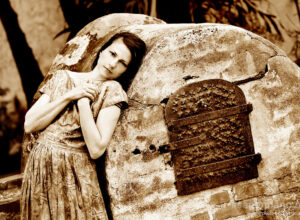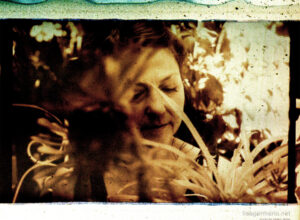By Alan Pedder
Wears the Trousers Magazine | January 26, 2010
Entering her third decade as a recording artist, Lisa Germano remains as individualistic and untouched by the fickle hand of trend as ever. Having refined her songcraft into an instantly recognisable collision of broken dreams and fractured, but never extinguished, hopes, Lisa’s latest album Magic Neighbor finds her at her most blackly humorous, the title track transforming the rather sordid real-life tale of a woman who had her two cats put down so that she could install a new kitchen – yeah, don’t even try to make sense of that – into an unnerving, witchy piano ballad (“He must be god, he can turn cats into pieces of furniture”). Where her previous album, 2006’s In The Maybe World, was largely fixated on mortality, Magic Neighbor is full of subtle twists that give it an openness we haven’t heard in her music for a long time. It’s as if Lisa’s curiosity about the lighter side of life finally got the better of her, the result being a slightly bemused self-awareness that most people could easily identify with.
Given the overwhelming sense of isolation that much of her music conveys, it’s easy to forget that she is one of the world’s most in-demand session violinists who has worked with a Who’s Who of indie rock and pop, but Germano’s recent collaboration with Radiohead’s Phil Selway on his forthcoming solo album has been keeping her busy and away from the phone. In lieu of a more personable chat, then, we sent her some questions over email to find out more about the making of Magic Neighbor, and exactly what she would do to that murderous woman if she had occult powers.
Magic Neighbor has been described as your first ‘daytime record’, and I love how that seems to be reflected in the artwork. Like how we’re faced with this dark, almost claustrophobic passage of vines on the cover, but then we open up the booklet to reveal bright blue waters and a coastal panorama. Was that the concept all along?
Not really all along, ’cause I don’t know what I’m doing or why until a certain point in the recording of my songs. Then the concept and artwork start to make themselves known, and if they begin to make sense, I go from there.
You’ve said that you didn’t have many new songs for this album. Were you inspired by your reworkings of ‘Except For The Ghosts’ and ‘In The Land Of Fairies’ on the last album, to go back and revisit old material?
Yes that helped, since I did look at those songs differently and enjoyed the outcome. And I also liked Jamie Candiloro’s recording of ‘Except For The Ghosts’. Where I had always recorded at home and then took songs to him to put on ProTools and work on them, this song we just recorded it at the last minute and it felt fresh to do it this way. So on this record that’s how we approached the whole project, and that’s also what makes it a daytime record. I didn’t really plan much except “Let’s record this song today” and just make it all up without much over-working. I tend to work on my stuff a lot at night and my past records did have a darker side to them because of this I think.
Which of these songs has been around the longest? Do you remember when you wrote it, and why you’ve kept it on the shelf for all this time?
The song ‘Simple’ is the first song I ever finished and my old recording of it was very dark and too slow and didn’t have the sense of humour that, now, looking at it again, I felt was there naturally, since I have such a distance from the actual feeling I wrote it from. I still feel it, it’s just not so self-absorbed.
It’s so nice to hear instrumentals on your albums again. It’s been a while! ‘Marypan’ is especially beautiful. What sort of images does that song conjure up for you as you play it?
I don’t have a particular image, but I do like Greg Leisz’s pedal steel on this a lot. And I do now have a cat named Marypan so I think of her sweet, big paws.
Some reviews I’ve read have misunderstood the meaning behind the song ‘Magic Neighbor’ somewhat. What a shocking tale! Was this the same person who called the superintendent on you for crying so much when Miamo-Tutti died?
Yes.
How soon after the incident did you write the song?
Well I wrote it while she was contemplating it, and I wouldn’t have put it on this record except that I realised the message was bigger than our personal problem. I changed the person to be a him to put a distance there, and also to see how this type of unconsciousness is the beginning of how people can blow their neighbours up. Like, even when you live next door, you can’t seem to change their behaviour and this is such a powerless, sad feeling.
If you had the power to turn her into a piece of furniture in revenge, what would you have turned her into?
I wouldn’t mess with her, I just wish her luck, hope she has more vision in the future and am REALLY glad she moved. OK, I would turn her into a big beautiful statue of a cat in memory of all the cats who are in need of love and consideration…and put it in a dog park.
To me, ‘The Prince Of Plati’ recalls ‘Red Thread’ from the last album in that it seems to be coming from two sides of a conversation. Is that right? It’s a lyrical style that really suits you. I’m always paying full attention to what’s going on when I hear it.
Yes, I guess this is true. I never think about these things…I just write what needs to come out.
‘Suli-mon’ is one of the strangest and most wonderful songs I’ve heard from you. Are you really singing “Tuna in my bowl”? And is that you making the cat noises? Sounds like you had a lot of fun with this one!
Yes I did. I had this song a year or so and never thought I could put it on a record, but it grew on me when I would sit at the piano and play it. I enjoyed changing the lyrics every time, not even having any particular lines, except I do say “Tuna in my bowl” pretty regularly. Suli-mon was a name we gave our cat Lou, as if he was a wise old sage with a beard so long it would go all the way through the room until just the tip of it stuck under the door. So when you came home you would know he was there and waiting for his tuna. Both comforting and demanding.
You co-wrote ‘Painting The Doors’ with avant-garde composer Harold Budd. What did the song originally sound like?
This song originally was Harold on piano and me singing with a lot of reverb and it was real slow. So when I thought of redoing it, I wanted it to be magical and not drab, so I thought all-autoharp could work, and it ended up being the whole basic track. Then Sebastian added a bass here and there and a mandolin. Finally it had a structure of sorts and I could add a vocal.
I read you are working at Whole Foods now. Do you feel you have even less time for your music these days?
It comes and goes. Right now I have been lucky to work with Philip Selway, the drummer from Radiohead, on his first solo record…which is beautiful; under the name Boybrain, I think. It’s not out yet. It’s been a great experience, but now, yes, I have to find some way of income, so may go back to Whole Foods if I can. I do believe in organic foods, meats without hormones and additives, free range chickens and eggs etc., sustainably fished fish. Many of the Whole Foods ideals go with mine and I live very much working around this.
You seemed to have a horrible time touring In The Maybe World in Europe. Was that a particularly difficult time for you?
Only parts of it were horrible, mostly due to a terrible tour manager who emotionally drained me. I didn’t have the energy to rise above some of my own songs. I have to actually be in a pretty good mood in order to present my songs with emotion, but not over the top drama…and anyway, I failed at this on parts of that tour. But a lot of it was amazing and I had great audiences who made it all worthwhile.
Our panel of writers voted Lullaby For Liquid Pig as one of the top 20 records of the last 10 years. How do you feel about that album, looking back at it now?
I think it’s a very true and moving record that isn’t everyone’s cup of tea. But for the people who relate to it, it seemed to be helpful for them and I’m honoured about this.
I’ve always wanted to know the secret behind how the album sleeve was done. Are you allowed to divulge the details of the magic trick?
It’s not all that hard, probably, with Photoshop. But the guys who did it, Matthew Welch and Paul McMenamin, are fantastic artists who had the great vision, and they did a great job.
Do you think we can expect any more archival releases with bonus material like Young God did with the …Liquid Pig reissue? That was such a treat!
Probably not. We actually hardly sold any of them. Ha ha. Typical for me.
Do you think we’ll ever get a proper retrospective anthology from you? Perhaps in 2011 to celebrate 20 years since Moon Palace?
Perhaps…





